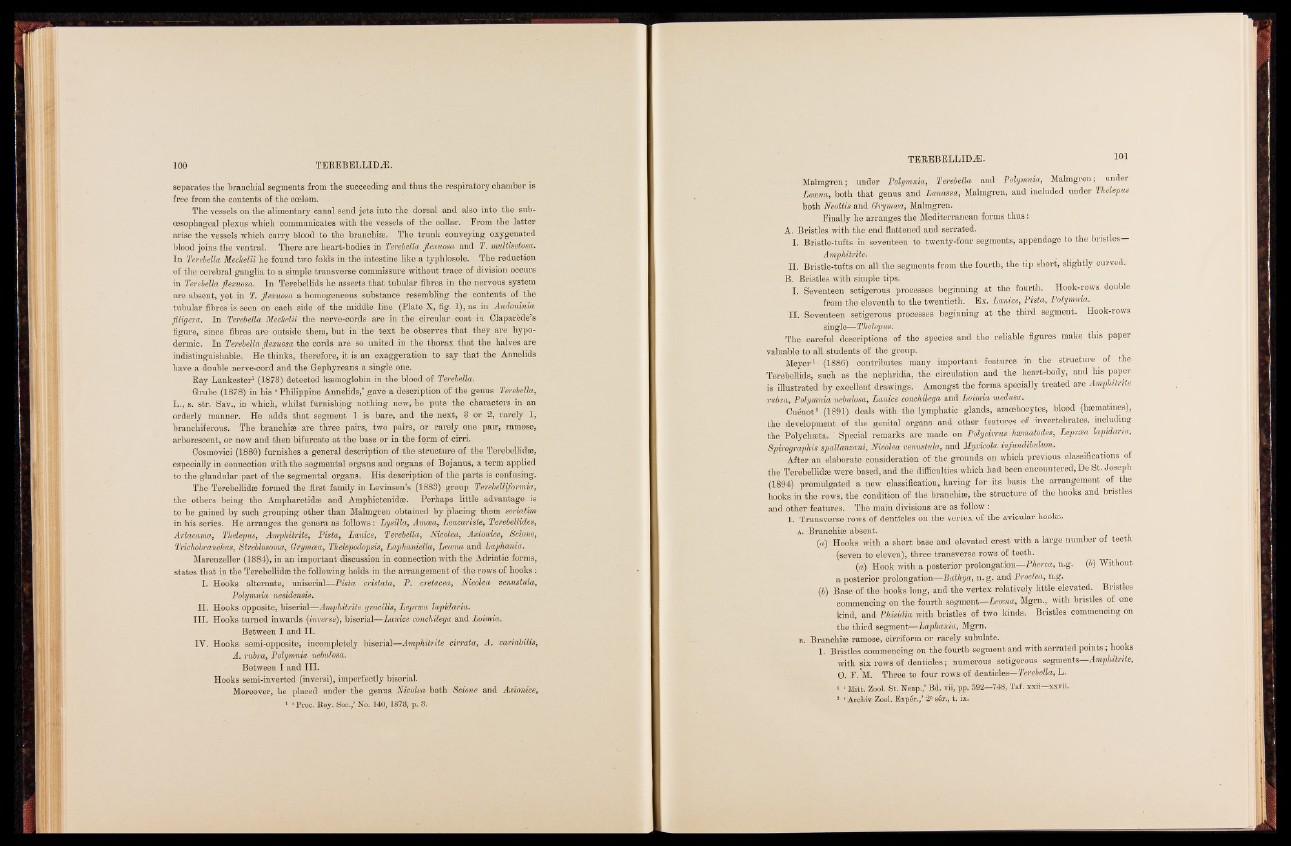
100 TBKEBELLID .
separates the branchial segments from the succeeding and thus the respiratory chamber is
free from the contents of the coelom.
The vessels on the alimentary canal send jets into the dorsal and also into the sub-
oesophageal plexus which communicates with the vessels of the collar. From the latter
arise the vessels which carry blood to the branchiae. The trunk conveying oxygenated
blood joins the ventral. There are heart-bodies in Terebella flexuosa and T. multisetosa.
In Terebella Meclcelii he found two folds in the intestine like a typhlosole. The reduction
of the cerebral ganglia to a simple transverse commissure without trace of division occurs
in Terebella flexuosa. In Terebellids he asserts that tubular fibres in the nervous system
are absent, yet in T. flexuosa a homogeneous substance resembling the contents of the
tubular fibres is seen on each side of the middle line (Plate X, fig. 1), as in Audouinia
filigera. In Terebella Meclcelii the nerve-cords are in the circular coat in Claparède’s
figure, since fibres are- outside them, but in the text he observes that they are hypodermic.
In Terebella flexuosa the cords are so united in the thorax that the halves are
indistinguishable. He thinks, therefore, it is an exaggeration to say that the Annelids
have a double nerve-cord and the Grephyreans a single one.
Ray Lankester1 (1873) detected haemoglobin in the blood of Terebella.
G-rube (1878) in his * Philippine Annelids,’ gave a description of the genus Terebella,
L., s. str. Sav., in which, whilst furnishing nothing new, he puts the characters in an
orderly manner. He adds that segment 1 is bare, and the next, 8 or 2, rarely 1,
branchiferous. The branchiae are three pairs, two pairs, or rarely one pair, ramose,
arborescent, or now and then bifurcate at the base or in the form of cirri.
Cosmovici (1880) furnishes a general description of the structure of the Terebellidae,
especially in connection with the segmental organs and organs of Bojanus, a term applied
to the glandular part of the segmental organs; His description of the parts is confusing.
The Terebellidae formed the first family in Levinsen’s (1883) group Terebelliformia,
the others being the Ampharetidse and Amphictenidae. Perhaps little advantage is
to be gained by such grouping other than Malmgren obtained by placing them seriatim
in his series. He arranges the genera as follows: Lysilla, Amosa, Leucariste, Terebellides,
Artacama, Thelepus, Amphitrite, Pista, Lanice, Terebella, Nicolea, Axionice, Scione,
Tnchobranchus, Streblosoma, Grymcea, Thelepodopsis, Laphaniella, Lecena and Laphania.
Marenzeller (1884), in an important discussion in connection with the Adriatic forms,
states that in the Terebellidse the following holds in the arrangement of the rows of hooks :
I. Hooks alternate, uniserial—Pista cnstata, P. cretacea, Nicolea venustula,
Polymnia nesidensis.
II. Hooks opposite, biserial—Amphitrite gracilis, Leprsea lapidaria.
III. Hooks turned inwards (inverse), biserial—Lanice conchilega and Loimia.
Between I and II.
IV. Hooks semi-opposite, incompletely biserial—Amphitrite cirrata, A. vanabilis,
A. rubra, Polymnia nebulosa.
Between I and III.
Hooks semi-inverted (inversi), imperfectly biserial.
Moreover, he placed under the genus Nicolea both Scione and Axionice,
1 ‘ Proc. Roy. Soc./ No. 140, 1873, p. 3;
TEREBELLIDSE.
Malmgren; under Polymnia, Terebella and Polymnia, Malmgren; under
Lecena, both that genus and Lanassa, Malmgren, and included under Thelepus
both Neottis and Grymcea, Malmgren.
Finally he arranges the Mediterranean forms thus:
A. Bristles with the end flattened and serrated.
I. Bristle-tufts in seventeen to twenty-four segments, appendage to the bristles
Amphitrite.
II. Bristle-tufts on all the segments from the fourth, the tip short, slightly curved.
B. Bristles with simple tips.
I. Seventeen setigerous processes beginning at the fourth. Hook-rows double
from the eleventh to the twentieth. . Ex. Lanice, Pista, Polymnia.
II. Seventeen setigerous processes beginning at the third segment. Hook-rows
single—Thelepus.
The careful descriptions of the species and the reliable figures make this paper
valuable to all students of the group.
Meye*:§(18®6)' : contributes many important features in the structure of the
i'-Serehellids, such as the nephridia, the circulation and the heart-body, and his paper
is illustrated by excellent drawings. Amongst thé forms specially treated are Amphitrite
rubra, Polymnia nebulosa, Lanice conchilega and Loimia medusa.
Cuénot2 (1891) deals with the lymphatic glands, amcebocytes, blood (hasmatmes),
the developments of the genital organs and other features of invertebrates, including
the Polychaeta. Special remarks are made on Polycirrus haematodes, Lepraea lapidaria,
Spirographis Spallanzani, Nicolea venustula, and Myxicola infundibulum.
After an elaborate consideration of the grounds on which previous classifications of
the Terebellidse were based, and the difficulties which had been encountered, De St. Joseph
(1894) promulgated a new classification, having for its basis the arrangement of the
hooks in the rows, the condition of the branchiae, the structure of the hooks and bristles
and other features. The main divisions are as follow :
I. Transverse rows of denticles on the vertex of the avicular hooks.
a. Br(aan)c hHiaoeo kabs swenitt.h a short base and elevated crest with a large number of teeth
(seven to eleven), three transverse rows of teeth.
(a) Hook with a posterior prolongation—Pherca, n.g. (b) Without
a posterior prolongation—Bathya, n. g. and Proclea, n.g..
(b) Base of the hooks long, and the vertex relatively little elevated. Bristles
commencing on the fourth segment—Lecena, Mgrn., with bristles of one
kind, and Phisidia with bristles of two kinds. Bristles commencing on
the third segment—Laphania, Mgrn.
b. Branchiae ramose, cirriform or rarely subulate.
| p j | Bristles commencing on the fourth segment and with serrated points; hooks
with six rows of denticles; numerous setigerous segments—Amphitrite,
O. F. M. Three to four rows of denticles— Terebella, L.
1 I Mitt. Zool. St. Neap.,’ Bd. vii, pp. 592—748, Taf. xxii—xxvii.
3 * Archiv Zool. Expér./ 2® sér., t, ix.